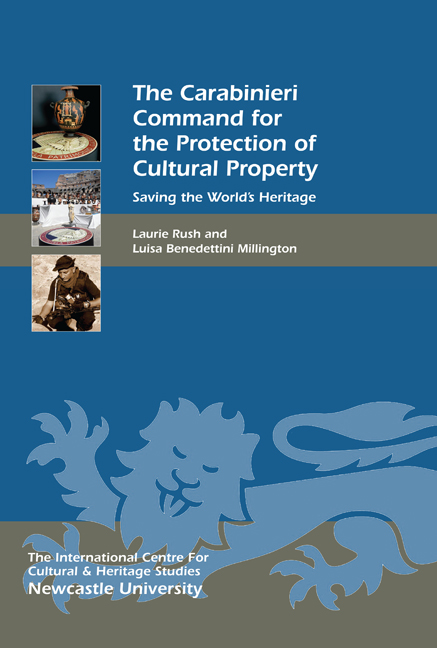Book contents
- Frontmatter
- Contents
- List of Illustrations
- Acknowledgments
- Foreword (in English and in Italian): Brigadier General Mariano Mossa
- Prefazione
- Abbreviations
- 1 The Carabinieri TPC: an Introduction and Brief History. Perché l’Italia? Why Italy?
- 2 Headquarters, the Databank and Operative Department in Rome
- 3 Carabinieri Public Outreach and Education
- 4 Central Italy and the Adriatic: Lazio, Florence, Bologna and Ancona
- 5 Activities in the North: Genova, Monza, Torino and Venezia
- 6 The Regional Offices: Naples, Bari and the South
- 7 The Challenges of the Island Regions: Sicily, Sardinia and the Palermo, Siracusa and Sassari Nuclei
- 8 Investigation Techniques
- 9 Repatriation of Works of Art to Italy: From Siviero to the Medici Conspiracy
- 10 Fakes, Forgeries and Money Laundering
- 11 Who Are the Officers of the Carabinieri TPC?
- 12 The Carabinieri, Peacekeeping and Foreign Relations: The Carabinieri Mission to Iraq
- 13 ‘The Italian Model’
- Bibliography and References
- About the Authors
- Index
- Heritage Matters
6 - The Regional Offices: Naples, Bari and the South
Published online by Cambridge University Press: 21 May 2021
- Frontmatter
- Contents
- List of Illustrations
- Acknowledgments
- Foreword (in English and in Italian): Brigadier General Mariano Mossa
- Prefazione
- Abbreviations
- 1 The Carabinieri TPC: an Introduction and Brief History. Perché l’Italia? Why Italy?
- 2 Headquarters, the Databank and Operative Department in Rome
- 3 Carabinieri Public Outreach and Education
- 4 Central Italy and the Adriatic: Lazio, Florence, Bologna and Ancona
- 5 Activities in the North: Genova, Monza, Torino and Venezia
- 6 The Regional Offices: Naples, Bari and the South
- 7 The Challenges of the Island Regions: Sicily, Sardinia and the Palermo, Siracusa and Sassari Nuclei
- 8 Investigation Techniques
- 9 Repatriation of Works of Art to Italy: From Siviero to the Medici Conspiracy
- 10 Fakes, Forgeries and Money Laundering
- 11 Who Are the Officers of the Carabinieri TPC?
- 12 The Carabinieri, Peacekeeping and Foreign Relations: The Carabinieri Mission to Iraq
- 13 ‘The Italian Model’
- Bibliography and References
- About the Authors
- Index
- Heritage Matters
Summary
The Naples TPC offices are located within a castle – an extraordinary historic structure and symbol of power, visible from throughout the city. The Castel Sant’Elmo dominates Naples from its position on the top of Vomero hill. It is a majestic star-shaped structure with six points and several moats. Originally built by the Angevins, a noble family of Frankish origin, in 1329 and called Belforte, it was restructured into a fortress by Viceroy Pedro Toledo in the 16th century. It has been recently restored and hosts special exhibitions in addition to housing the TPC offices. Visitors can also visit the palace terraces and prisons.
As is the case throughout Italy, the protection of art and archaeology in Naples and the South represents an extraordinary challenge. Along with the ancient cities of Pompeii and Herculaneum, the multitude of palaces, villas, private collections, archaeological sites, heritage landscapes, libraries, archives and churches (that are sometimes left open to the public without supervision) require constant vigilance on the part of the Naples CC TPC. Unfortunately there are thousands of stolen artworks and antiquities already recorded in Banca Dati Leonardoand art crimes large and small are planned and executed on an almost daily basis.
A recovered statue of Agrippina the Younger, mother of Roman emperor Nero, illustrates one aspect of the range of challenges. Dating from between 100 BC and AD 50 and stolen sometime between 1984 and 1990 from Pompeii, the terracotta statue surfaced in Parma when a dentist who had the statue hidden in his possession for years attempted to sell it through a dealer in Piacenza. The statue was identified and secured by the Carabinieri TPC based in Parma, who also recognised the tremendous historical significance of the object. Both the dentist and the dealer were arrested for possession of stolen archaeological material (Huffington Post2012).
GIROLAMINI LIBRARY DISASTER
The Girolamini Library in Naples (see Fig 6.1) is one of 46 state libraries in Italy. It holds around 160,000 volumes (mostly rare and antique books) including 160 incunabula and 6500 manuscripts of musical compositions dating from the 16th to the 19th centuries.
- Type
- Chapter
- Information
- The Carabinieri Command for the Protection of Cultural PropertySaving the World's Heritage, pp. 81 - 94Publisher: Boydell & BrewerPrint publication year: 2015



